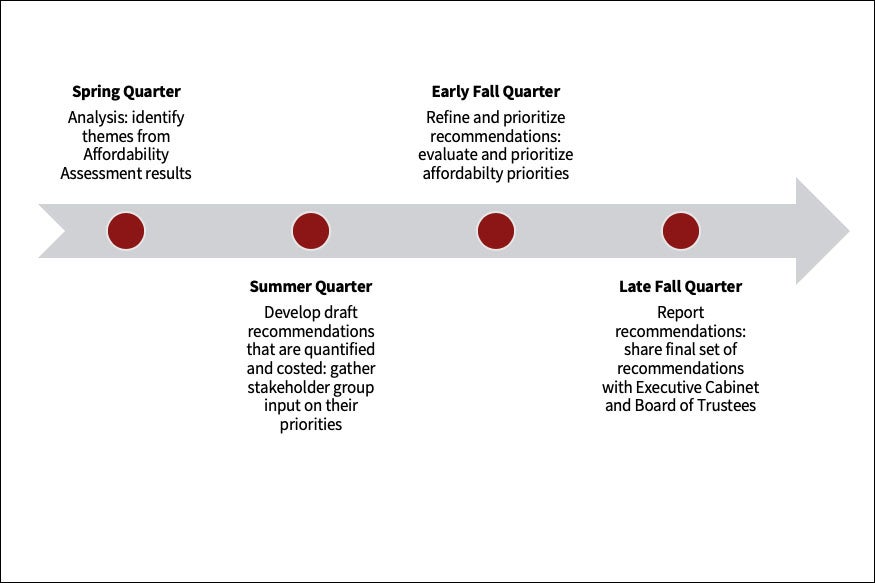Affordability is a challenge across groups at Stanford and within the Bay Area. But differing needs of the various communities require approaches that are customized for those groups.
That’s one of the key learnings so far by the Affordability Task Force (ATF), a group formed as part of the university’s long-range planning effort, and which is now midway through its process. The ATF is working to develop a set of sustainable, widespread and data-informed recommendations to address near- and long-term affordability issues associated with housing, child care, transportation and benefits.
“Our team is still digging through a significant amount of data and community input,” said Elizabeth Zacharias, vice president for human resources and ATF chair. “In general, findings are highlighting that addressing the difficult issues is not a ‘one size fits all’ approach. What might work for one group won’t work as well for another group.
“Ensuring we seriously explore the issues and analyze all the information and ideas gathered by the task force over the past several months is important to our development of viable recommendations.”
Stanford has a longstanding commitment to addressing key affordability needs of its constituents , Zacharias noted, including free transit passes and other transportation benefits, new satellite worksites closer to some employees’ homes, child care subsidies and additional child care facilities, and college tuition and medical contribution assistance programs for faculty and staff, among other programs. Now, however, recognizing the broad and increasing nature of the affordability challenges in the Bay Area, the ATF is seeking additional solutions, she said.
Analysis under way
The ATF has organized its work around five constituencies: faculty, academic staff, staff, postdoctoral scholars and graduate students. Stakeholder teams were formed specific to each of these constituencies.
A significant amount of outreach has helped the teams to research and assess affordability challenges, as well as to gather ideas to address affordability concerns. The stakeholder groups have conducted focus groups, surveys and town hall meetings to better understand affordability issues in each topic area.
In winter quarter, the ATF also worked with an outside consultancy to conduct in-depth affordability assessments. These assessments measured opinions of the constituency groups about a variety of topics, and asked participants to prioritize their perceived value of different programs and offerings that may address affordability.
The assessments had strong levels of participation, with a university-wide response rate of 49 percent, representing a total of 13,709 community members who completed the assessments. For the five groups, response rates ranged from 33 percent to 60 percent, showing a high degree of interest in affordability across all groups.
The top finding across all groups was that an overwhelming majority of respondents are attracted by the work/research at Stanford, and point to Stanford’s reputation, facilities and colleagues as decision factors in working at Stanford. Balancing those attractive factors with the regional affordability issues experienced by anyone living and working in the Bay Area is a key focus of the ATF. Additional results include:
- Financial stress is experienced by all groups, with 35 percent of faculty, 40 percent of staff, 62 percent of postdocs and 49 percent of graduate students describing their financial situation as “stressful.”
- When it comes to child care, for respondents with children under age 14, most indicate some or great difficulty finding affordable and/or available care.
- Transportation results show that 65 percent of staff seek additional ways to lessen commute times, including telecommuting and commuting during non-peak hours. The majority of graduate students want more subsidized transit options.
- The Stanford Contributory Retirement Plan (SCRP) was ranked as highly important by both faculty and staff.
The work ahead
The next several months are critical to developing a comprehensive set of recommendations. The ATF stakeholder teams are developing proposals based upon both the affordability assessment data and the stakeholder groups’ research findings. As the recommendations are developed, they will be evaluated based on cost and design criteria, then prioritized within the stakeholder groups and shared with the ATF Steering Committee in late summer.
During fall quarter, the ATF will finalize an overall set of prioritized recommendations to present to the Executive Cabinet and subsequently to the Board of Trustees in December. A visual timeline is provided below.
The ATF can be contacted at affordabilitytaskforce@stanford.edu. Visit the Our Vision website for updates on this and other initiatives.
